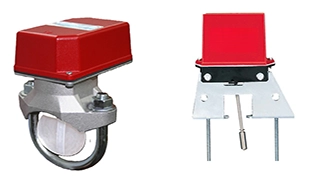Monitoring components are critical to the effectiveness, reliability, and code compliance of modern firefighting systems. These devices provide continuous oversight of system status, ensuring that water-based fire protection systems such as sprinklers, standpipes, and hydrants remain in a state of readiness—and that any abnormal condition is quickly identified and addressed
Key monitoring devices include:
Pressure Gauges
Installed on sprinkler and standpipe systems, pressure gauges provide real-time readings of water or air pressure within the piping network. They are essential for verifying system pressurization, detecting pressure loss, and assisting in routine inspection, testing, and maintenance.Flow Switches
These devices detect water movement in sprinkler risers or branch lines, indicating that a sprinkler head has activated and water is flowing. When triggered, flow switches send a signal to the fire alarm control panel, initiating audible/visual alarms and alerting monitoring stations.Pressure Switches
Used to monitor specific pressure thresholds, pressure switches are often installed on fire pumps, air supplies (in dry or pre-action systems), or supervisory lines. They trigger alerts if pressure falls below or exceeds normal operating ranges, helping detect leaks, pump failure, or valve closures.Supervisory Switches
Installed on control valves (such as OS&Y, butterfly, or PIV valves), supervisory switches monitor the open or closed position of critical valves. A signal is sent to the fire alarm panel if a valve is tampered with or inadvertently closed—helping prevent system disablement before an emergency occurs.
These monitoring devices are interfaced with fire alarm and building management systems, enabling centralized visibility, alarm signaling, and integration with emergency response protocols. They also support compliance with NFPA 13, NFPA 72, and NFPA 25, which require regular testing and inspection to ensure operational integrity.
Together, these monitoring components form a vital part of an intelligent fire protection system—ensuring early detection of faults, system readiness, and rapid response in the event of fire.


